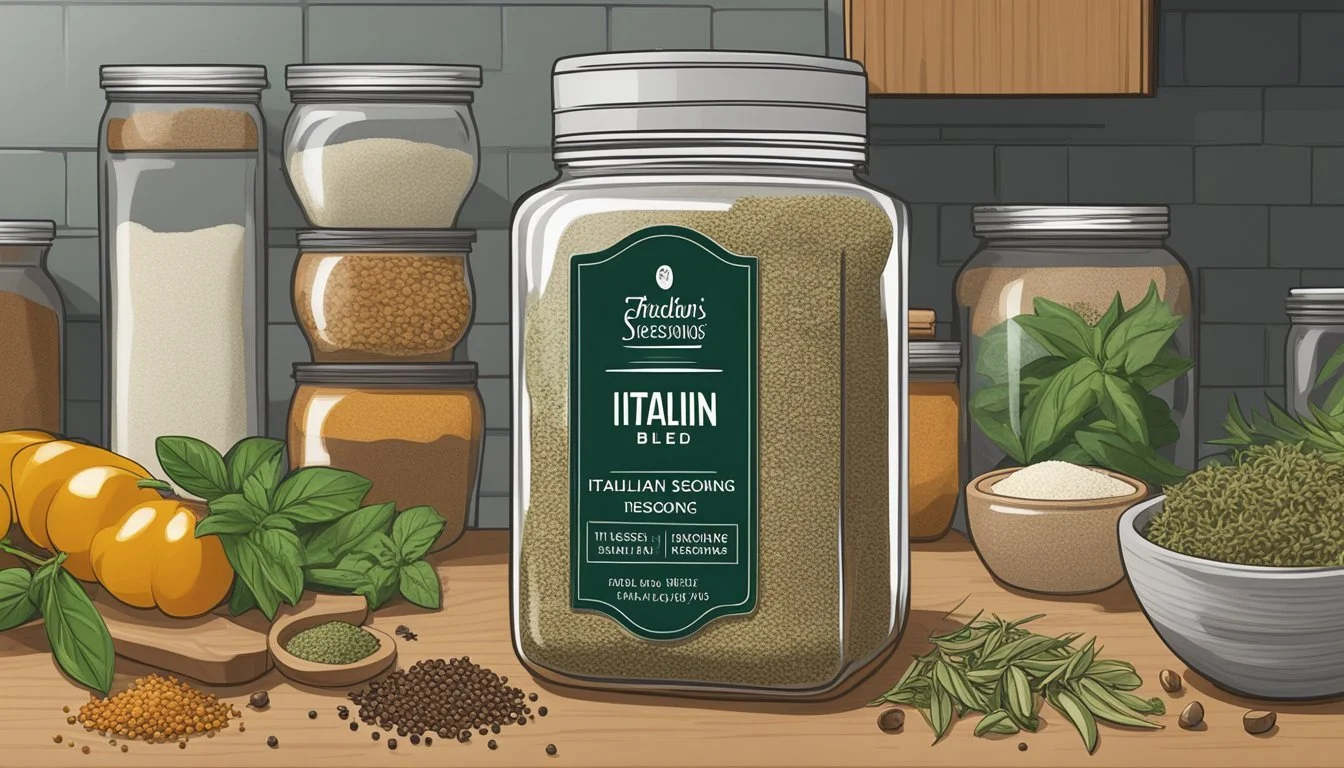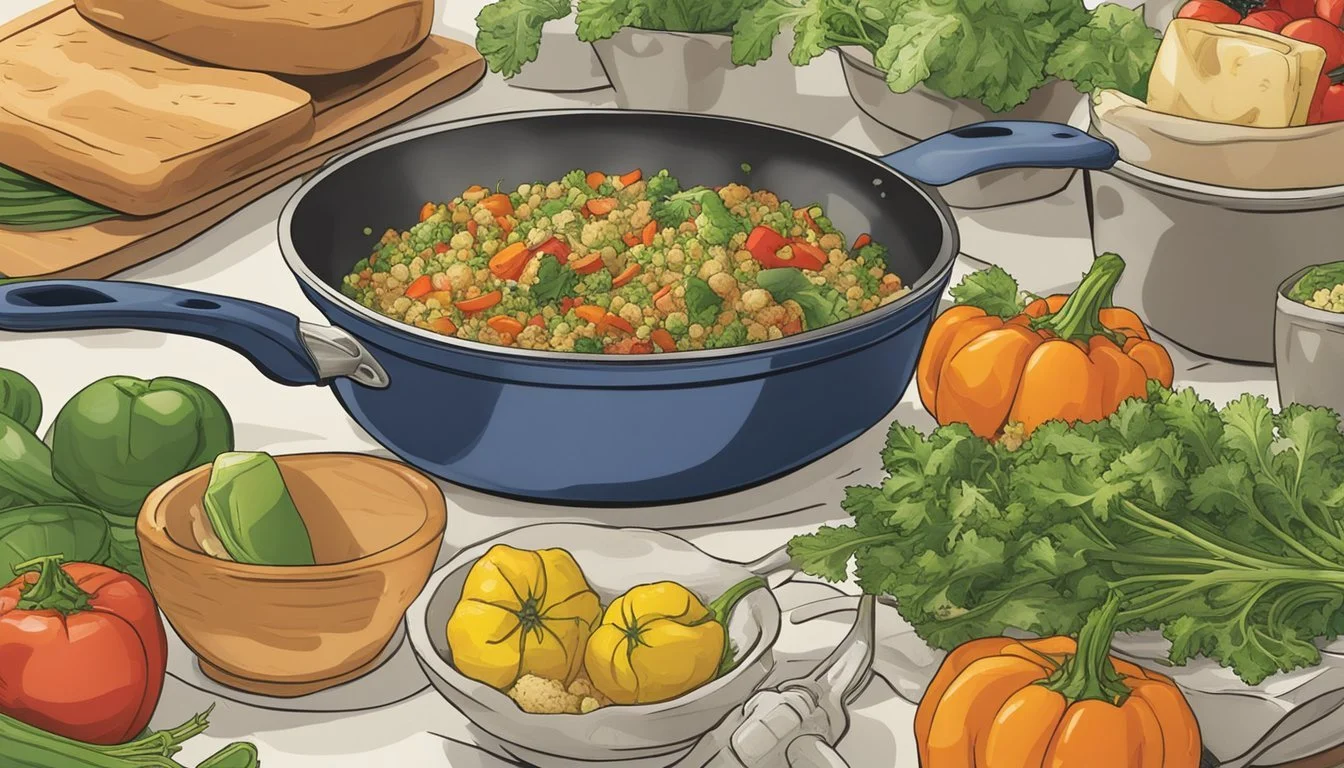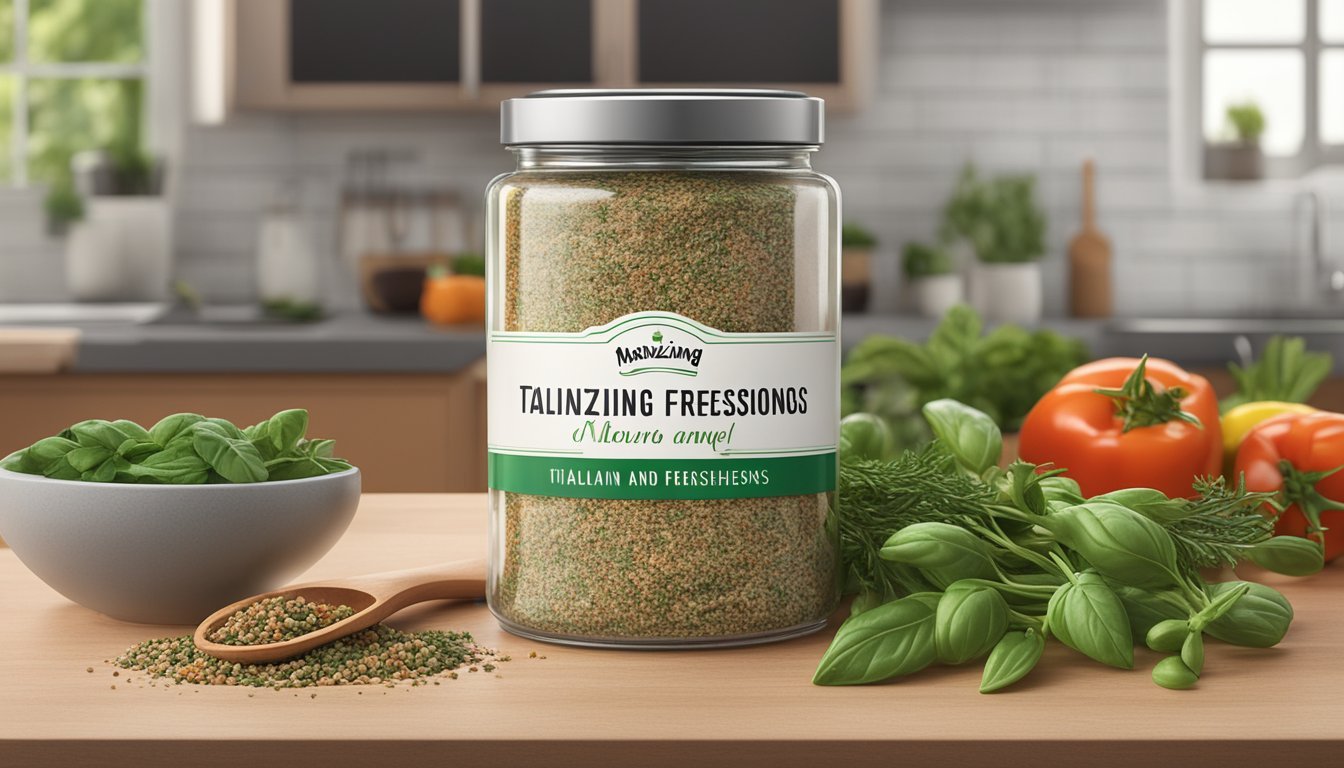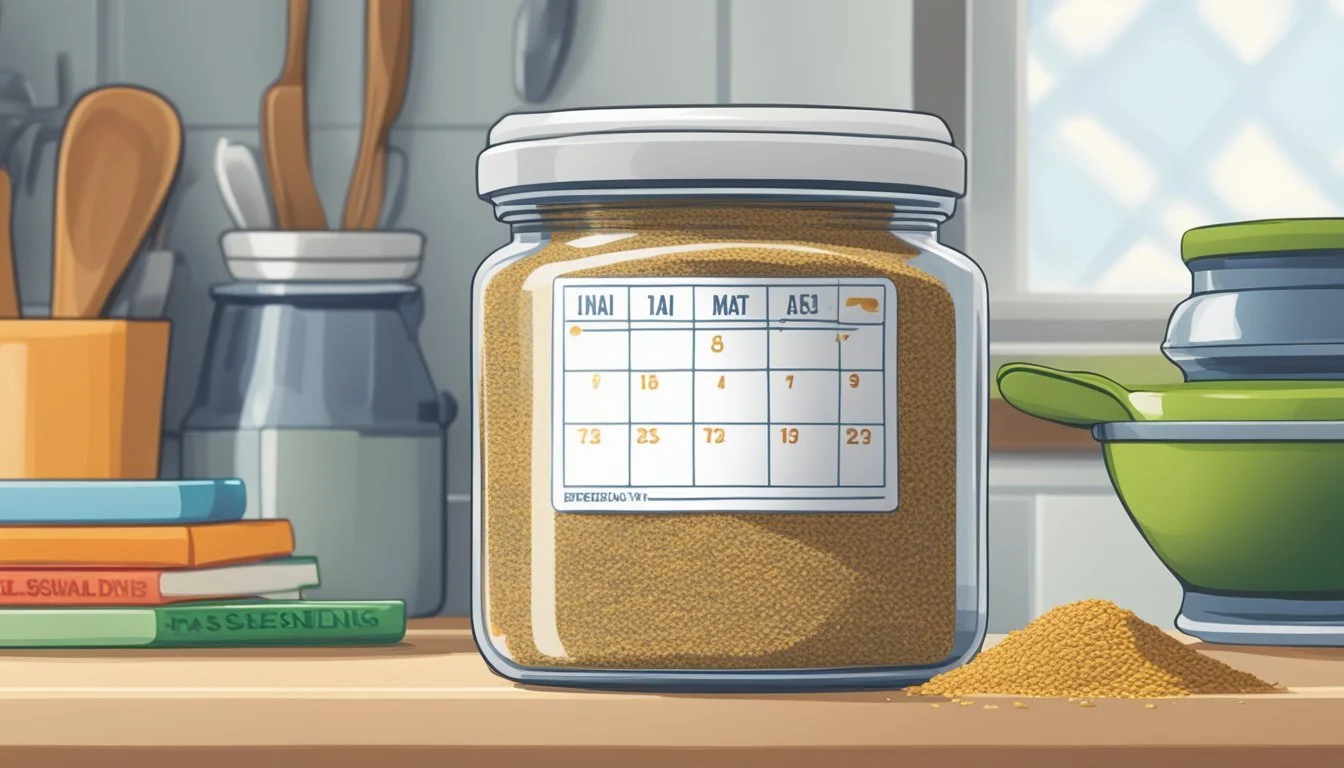How Long Does Italian Seasoning Blend Last?
Shelf Life and Storage Tips
Italian seasoning, a quintessential blend of dried herbs, embodies the essence of Italian cuisine. Its robust flavor is an amalgamation of key ingredients such as basil (how long does basil last?), oregano, rosemary, and thyme. The longevity of Italian seasoning is an aspect that many cooks consider when aiming to maintain the potency and aromatic qualities of this versatile blend.
The shelf life of Italian seasoning varies depending on its form and storage conditions. Freshly blended seasoning can last for 1 to 2 weeks when refrigerated, while a pre-packaged mix has a significantly longer lifespan. Stored properly in a cool, dark place within an airtight container, pre-packaged Italian seasoning can retain its quality for up to 2 to 3 years. This duration ensures that the flavors remain as close to their original state as possible, keeping them ready to enrich a variety of dishes with the signature taste of Italy.
Knowing how to store Italian seasoning effectively is key in preserving its flavors. Protecting the seasoning from light, heat, and moisture will help maintain its aroma and taste, ensuring that it enhances culinary creations as intended. Whether making the blend at home or purchasing it from a store, proper storage is paramount for extending the life of Italian seasoning and making the most out of this blend in everyday cooking.
Understanding Italian Seasoning
Italian Seasoning is a blend of dried herbs that are commonly used in Mediterranean cuisine. This combination offers a versatile flavor profile and due to the dried nature of its components, it possesses a long shelf life when stored correctly.
Components of Italian Seasoning
Italian Seasoning typically consists of the following herbs:
Basil: Contributes a sweet and slightly peppery flavor.
Oregano: Offers an earthy, sharp tang with a slightly bitter taste.
Rosemary: Adds a woody, citrus-like fragrance and astringent flavor.
Thyme: Imparts subtle, dry aroma with a slight minty quality.
Marjoram: Similar to oregano, but with a sweeter and less pungent taste.
Parsley: Delivers a fresh, slightly peppery flavor when included.
Sage: Used less commonly, it provides a slight peppery flavor with hints of mint.
These herbs are generally found in equal proportions within the blend, however, variations might occur according to different recipes or regional preferences.
Flavor Profile
The flavor profile of Italian Seasoning is robust and complex, marked by the following characteristics:
Herbaceous: Dominantly green and fresh notes coming especially from basil and parsley.
Earthy: Grounded tones mainly from oregano and thyme.
Aromatic: Evocative scents from all components, particularly rosemary and sage, which offer piney and minty accents, respectively.
Warm: A mild warmth is typical due to the slight spiciness of sage and black pepper if included.
This combination is designed to enhance a variety of dishes, from pasta and pizza to grilled vegetables and meats. Its wide application in Italian and Mediterranean cooking makes it a staple in many kitchens.
Proper Storage of Italian Seasoning
To ensure the longevity and freshness of Italian seasoning, it is vital to pay attention to storage conditions and the types of containers used.
Ideal Storage Conditions
Italian seasoning retains its potency and flavor best when stored in a cool, dry place, away from direct light. A pantry or cupboard typically provides an ideal environment, as these locations are usually away from the heat of the kitchen and any sunlight. Temperature fluctuations and humidity are two enemies of dried herbs and spices, and therefore, one should be proactive in keeping Italian seasoning in consistently cool and dry conditions.
Types of Containers
For maintaining the quality of Italian seasoning over time, airtight containers are recommended. The ideal choices are:
Glass jars with tight-fitting lids
Durable plastic containers with sealed closures
Using clear glass jars can be visually appealing, but if they are not stored in a dark place, one should opt for tinted glass to protect the herbs from light. Furthermore, it is crucial that the containers are clean and dry before filling them with seasoning to prevent any mold or bacterial growth. Containers should also be sized appropriately to the amount of seasoning to minimize air exposure.
Whether in glass or plastic, the container must seal properly to keep out moisture and other contaminants. The containers can be labeled with the date of packaging to help keep track of freshness.
Shelf Life Factors
Italian seasoning blend's longevity relies heavily on how it's stored. Light, heat, and moisture are the adversaries of preservation, impacting both the flavor and shelf life. Proper storage is crucial in preserving the blend's quality.
Impact of Storage Methods
Impact of Airtight Containers: Storing Italian seasoning in an airtight container is critical. It prevents exposure to air which can lead to staleness.
Location: Store the seasoning in a cool, dark place, away from sunlight, to prevent degradation of flavors.
Avoiding Heat and Moisture: Heat can cause spices to lose their potency, and moisture can introduce mold. Hence, one should not store Italian seasoning near stoves or sinks.
Signs of Deterioration
Visual and Aromatic Clues: Fading color indicates the seasoning is past its prime, and a diminished aroma suggests a loss in potency.
Presence of Mold or Clumps: If the seasoning blend has visible mold or if it has clumped together, this is a sign that moisture has compromised the product and it should not be used.
Usage of Italian Seasoning in Cooking
Italian seasoning is a versatile spice blend that enhances a wide array of dishes. It's a key ingredient in Italian cuisine, known for imparting a robust flavor to recipes ranging from sauces and soups to grilled meats and vegetables.
Typical Recipes Incorporating Italian Seasoning
Pasta Dishes:
Spaghetti Bolognese: Italian seasoning is used to deepen the flavor of the sauce.
Lasagna: It's added into the tomato sauce layer, contributing to the dish's signature taste.
Pizza:
Homemade Pizza Sauce: A dash of Italian seasoning can transform tomato sauce into an aromatic pizza sauce.
Pizza Toppings: Sprinkling the seasoning over the pizza adds a herby crust that complements the cheese and toppings.
Meats and Marinades:
Chicken: Incorporate Italian seasoning into a marinade with olive oil and lemon juice to create a flavorful chicken dish.
Grilling and Roasting: It can be rubbed onto meats before grilling or roasting for enhanced taste.
Soups and Vegetables:
Vegetable Soups: A teaspoon of Italian seasoning can provide a complex flavor profile to a simple vegetable soup.
Roasted Vegetables: Toss vegetables with olive oil and Italian seasoning before roasting for a delicious side dish.
Customizing Your Blend
Homemade Spice Blend:
Create a personalized Italian seasoning by adjusting the proportions of dried herbs like basil, oregano, rosemary, thyme, and marjoram based on preference.
Beyond Italian:
Customize your blend to adapt to different cuisines:
Cajun Influence: Incorporate spices like paprika and cayenne to create a fusion with Cajun seasoning.
Mexican Twist: Add some cumin and chili powder to turn it into a quick taco seasoning alternative.
By tweaking the blend, one can tailor Italian seasoning to suit a variety of recipes and cooking methods, from marinades to roasting, grilling, or enhancing sauces.
Maximizing Flavor and Freshness
Ensuring an Italian seasoning blend maintains its flavor and aroma over time hinges on proper storage and the use of quality herbs. Here's how one can revitalize older seasonings and create vibrant homemade blends to add a burst of Italian flavor to dishes.
Revitalizing Older Seasonings
When an Italian seasoning blend begins to lose its potency, there are steps one can take to coax out a bit more flavor. It is advisable to gently heat dried herbs like dried basil, dried oregano, dried rosemary, and dried thyme (how long does dried thyme last?) in a dry pan over low heat. This can help release remaining oils and revive the aroma of the seasoning. The herbs should be watched closely to prevent burning, as this would create a bitter taste.
Creating Homemade Italian Seasoning
One retains the most flavor by mixing fresh, high-quality dried herbs. To create a homemade Italian seasoning, combine equal parts of dried basil, dried oregano, dried rosemary, and dried thyme in a mixing bowl. Whisk them together and store the mixture in an airtight container, shielded from light and heat. Homemade blends can remain flavorful for up to six months and imbue sauces and various dishes with a robust, Italian taste. Fresh herbs, while not typically used in dry seasoning blends, are ideal for adding an extra burst of flavor to cooked dishes just before serving.
Considerations for Dietary Needs
When incorporating Italian seasoning into one's diet, two key factors to address are the nutritional content of the blend and its compatibility with various allergy and dietary restrictions. Italian seasoning can complement a healthy diet as it is typically sugar and salt-free, adding flavor without unnecessary additives.
Nutritional Information
Italian seasoning is made from a blend of dried herbs such as basil, thyme, rosemary, marjoram, parsley, and oregano. These herbs contribute minimal calories to the diet but can offer a range of vitamins and minerals. For individuals monitoring their caloric intake, using Italian seasoning to enhance the flavor of dishes is a beneficial choice.
Allergy and Dietary Restrictions
Gluten-Free: Italian seasoning inherently does not contain gluten, making it suitable for those with celiac disease or gluten sensitivity.
Allergen Consideration: As Italian seasoning is a mix of various herbs, it's essential to ensure that individuals are not allergic to any components. It's generally free of major allergens.
It is important for individuals with dietary restrictions to verify the ingredients of pre-packaged Italian seasoning blends, as some manufacturers may include additives or fillers that are not compliant with all dietary needs.
Comparing Italian Seasoning Variants
Italian seasoning blends vary significantly in terms of shelf life and flavor profile depending on whether they are store-bought or homemade, as well as regional and cultural influences.
Store-Bought vs. Homemade
Store-Bought Italian seasoning, when properly stored in airtight containers away from light, heat, and moisture, can maintain its quality for about 2 to 3 years. These blends are typically composed of dried oregano, basil, thyme, rosemary, marjoram, and parsley, offering convenience and a longer shelf life due to preservatives and controlled packaging processes.
Homemade Italian seasoning, while fresher and possibly more flavorful due to the customization of the spice mix, usually lasts for about 1 to 2 weeks in the refrigerator if fresh herbs are used. If one uses dried herbs, however, the shelf life can extend up to 6 months, provided it is stored correctly in a cool, dark place.
Regional and Cultural Variations
Italian seasoning blends may also vary based on regional and cultural preferences, which can affect their shelf life and flavor profile. Some cultural variations may include additional spices, altering the blend's potency and versatility. For instance, a Mediterranean twist might include dried lemon zest (how long does lemon zest last?) or a hint of crushed red pepper for added heat.
It is important to note that while the core ingredients remain consistent, slight alterations in the herb proportions or additional spices influenced by regional cuisines can make these seasoning blends quite unique and can also play a role in their longevity when stored.
Frequently Asked Questions
When managing a blend of Italian seasoning, understanding storage and shelf life extension techniques is crucial. The following information will assist in ensuring the seasoning remains flavorful for as long as possible.
Storing Mixed Herbs
To maintain the quality of Italian seasoning, one has to store it in an airtight container and place it in a cool, dark area away from direct sunlight and heat sources. Containers with tight-fitting lids are preferable. For fresh homemade blends, the refrigerator can be used, and they typically last for up to 1-2 weeks. Dried herbs, on the other hand, have a longer shelf life and can be stored efficiently in the pantry.
Shelf Life Extending Tips
Maximizing the shelf life of Italian seasoning requires a few simple yet effective strategies:
Avoid moisture: Ensure the herbs are completely dry before sealing them in the container.
Minimize air exposure: The less air that comes into contact with the seasoning, the longer it will retain its potency.
Use fresh ingredients: If making a homemade mix, start with fresh, high-quality dried herbs.
Check expiration dates: For combined blends, the shelf life is often determined by the spice with the shortest expiration date.
Storing Italian seasoning properly can result in a shelf life of up to 2 to 3 years without significant loss of flavor. However, the potency and aroma will diminish over time, and it is advised to test the seasoning before use after extended storage to ensure it still meets flavor expectations.
Additional Uses Beyond Cooking
Beyond its culinary applications, an Italian seasoning blend serves multiple purposes around the household and can contribute to health and wellness regimes. While it is primarily associated with enhancing the flavors of meats and vegetables in the kitchen, its components can be utilized in unforeseen ways.
Household Applications
Italian seasoning can be a natural scent enhancer for various household items. For instance:
Carpet Freshener: Mixing Italian seasoning with baking soda and sprinkling it on carpets before vacuuming can impart a pleasant, earthy aroma to a room.
Potpourri: Dry Italian seasoning can contribute to a homemade potpourri mix, providing a Mediterranean scent when placed in bowls around the home.
Health and Wellness
In the realm of health and wellness, Italian seasoning's herbs can have several benefits:
Soothing Herbal Baths: Adding ground Italian seasoning to bathwater can create a herbal soak that may help in relaxation and skin health.
Aromatherapy: The herbs used in Italian seasoning, including oregano and rosemary, can be dried, bundled, and burned like incense or used in essential oil diffusers. This may aid in reducing stress and promoting a calming atmosphere.
The Future of Seasoning Blends
The seasoning industry continues to evolve, with significant advancements shaping the way spice blends are crafted and preserved. This evolution speaks directly to consumer preferences and technological innovation.
Trends in Culinary Seasoning
Culinary trends indicate a growing demand for unique and diverse flavor profiles. Consumers are increasingly seeking out bold and authentic blends that can provide a global tasting experience from the comfort of their homes. In response, producers are expanding their offerings to include not just traditional Italian seasoning blends but also spices from around the world, sometimes merging them to create fusion flavors.
Globalization of Palates: Incorporation of exotic spices to cater to adventurous tastes.
Health-Conscious Blends: Rise in seasoning blends that support a healthy lifestyle, such as low-sodium and no-additive options.
In addition to taste, there's an emphasis on the sourcing of ingredients, where ethically sourced and organic spices are becoming more prevalent. This conscientious approach is reflected in the labeling and marketing of spice jars, transparently conveying their origins and quality to informed consumers.
Innovations in Blend Preservation
Advancement in preservation technology ensures that the flavor, color, and aroma of spice blends are retained for longer periods. Manufacturers are investing in improved packaging solutions, such as high-barrier spice jars, to protect against moisture, air, and light — the primary culprits in flavor degradation.
High-Barrier Packaging: Use of materials that extend shelf life while maintaining spice blend quality.
Smart Packaging: Incorporating technology that alerts consumers to freshness and potential spoilage.
Additionally, there is a notable shift towards natural preservation methods that don't rely on artificial preservatives. These innovations contribute to a future where seasoning blends are not only more robust in flavor but also healthier and more sustainable. The industry is moving towards a model where the longevity of spice blends aligns with a growing consumer expectation for natural ingredients and minimal processing.
Conclusion
When it comes to the longevity of Italian seasoning, the key factors are storage and the form of the seasoning. Homemade Italian seasoning typically lasts for 1-2 weeks in the refrigerator, while pre-packaged seasoning has a much longer shelf life, generally 2 to 3 years when stored correctly. To ensure your Italian seasoning retains its flavor and potency, proper storage in airtight containers is crucial. These containers should be placed in a cool, dark, and dry area.
To summarize the storage guidelines:
Store away from light, heat, and moisture
Use airtight containers for maximum freshness
Check for the expiration date on pre-packaged seasonings, but remember they can often last longer if stored properly
Consumers should rely on their senses as well—aroma, color, and flavor are good indicators of freshness. If the seasoning appears dull or has a weakened scent, it might be time to replace it. Always remember that while the seasoning might not spoil in a way that renders it unsafe, its quality and taste may diminish over time, affecting the flavor of your dishes.
In terms of safety, it can generally be said that Italian seasoning remains safe to use after the expiration date on the package, provided it has been stored correctly. However, for optimal taste, adhering to the advised timeframes can enhance the quality of your culinary endeavors.













